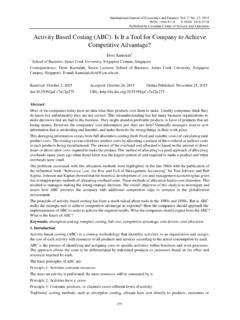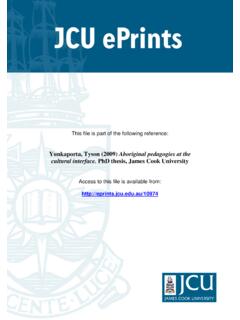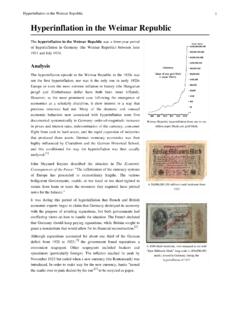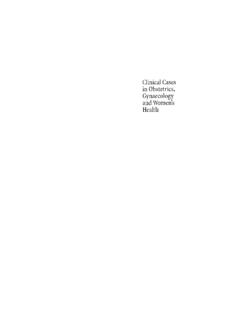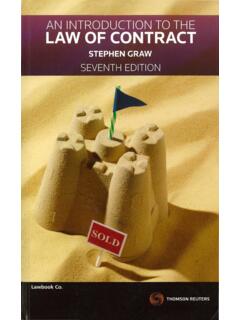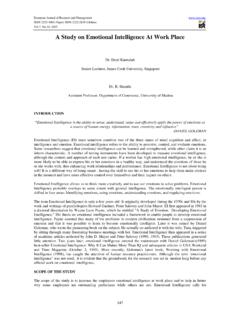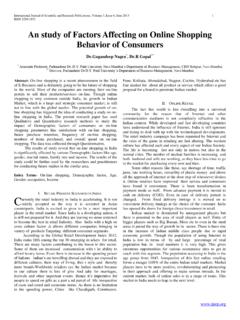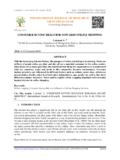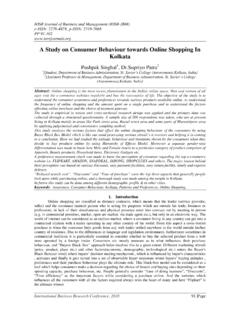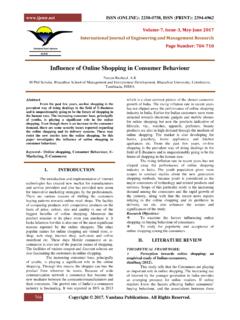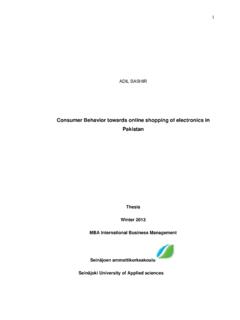Transcription of Consumers’ Perception on Online Shopping
1 Journal of Marketing and consumer Research ISSN 2422-8451 An International Peer-reviewed Journal , 2015 14 Consumers Perception on Online Shopping Dr. Desti Kannaiah2 1. Assistant Professor, Department of Commerce, University of Madras, Chennai -600005, Tamil Nadu, India 2. Senior Lecturer, School of Business, James Cook University, 149 Sims Drive, Singapore -387380. Abstract E-commerce is emerging as a great level given that organized retail is still not ubiquitous across the length and breadth of the country with large retail chains making up less than 10% of the is helping people in smaller towns in India access quality products and services similar to what people in the larger cities have access to.
2 It being forecast that close to 60% of Online shoppers would come from beyond the top eight large cities by end of this internet penetration has helped to expand the potential customer pool. Internet penetration is only about 10% (or about 121 million users) as against about 81% in the US and 36% in China. However this number continues to rise at a consistent pace because of falling prices for broadband connections. The first World Wide Web server and browser, created by Tim Berners-Lee in 1990, opened for commercial use in 1991. Thereafter, subsequent technological innovations emerged in 1994: Online banking, the opening of an Online pizza shop by Pizza Hut, Netscape's SSL v2 encryption standard for secure data transfer, and inter-shop s first Online Shopping system. Immediately after, launched its Online Shopping site in 1995 and eBay was introduced in 1996.
3 In the past decade, there has been a dramatic change in the way consumers have altered their way of Shopping . Although consumers continue to purchase from a physical store, consumers feel very convenient to shop Online since it frees the customer from personally visiting the store. Internet Shopping has its own advantages and it reduces the effort of travelling to a physical store. Decisions can be made from home at ease looking at various choices and prices can be easily compared with the competitor s products to arrive at a decision. This study highlights student s attitude towards Online Shopping and their product preference on Online Shopping . This enable the e-retailers to support their Online customer better by developing suitable marketing strategy in order to attract and convert potential customer as an active customers by encouraging them in an efficient way to make a purchase decision.
4 Keywords: Online Shopping , consumer Perception , buying Behaviour, Purchase Decision, e-Commerce 1. Introduction Internet marketing is conceptually different from other marketing channels and internet promotes a one to one communication between the seller and the end user with round the clock customer service. Today, business internet marketing is the fastest growing segment of Online commerce. The major difference between traditional and Online selling is the extent of interaction between the consumer and the seller. There is much more electronic interactivity with the consumer in the form of emails and FAQs. Through FAQs, the consumer s questions on shipment, payment, product, policies and other customer concerns can be addressed effectively (Pervaiz Ali,2011). Increasing numbers of people are gravitating towards more intensive use of the Internet as the accessibility of technology, the availability of information, and the ability to interact through the Internet increase and evolve.
5 Obvious capabilities of the Internet include avenues for gathering information, purchasing a product, or rendering a service. These advances in Internet technology allow for the expansion of Shopping options beyond traditional methods that may be more time consuming. Issues with having to physically gather information with offline Shopping methods are alleviated, and customers are better able to efficiently use their time. For instance, instead of having to physically visit different stores to compare prices or rely on circular pamphlets in newspapers, a consumer is able to search and retrieve needed information through the Internet. The Internet explosion has opened the doors to a new electronic world. Consumers are now able to use the Internet for a variety of purposes such as research, communication, Online banking, and even Shopping .
6 With such advantages, the Internet is rapidly becoming the main method of communication and of conducting business conveniently. With a growing number of households turning towards the Internet and the world of e-commerce to shop, invest, make payments, and do Online banking, new technological advancements will have to come about to make these transactions secure. However, not all consumers are participating in Online transactions as part of the Internet boom. As more and more businesses continue to establish an Online presence, they are finding that some Journal of Marketing and consumer Research ISSN 2422-8451 An International Peer-reviewed Journal , 2015 15 consumers are still reluctant to shift in that same direction.
7 For various consumers there are still concerns with security and passing personal data over the Internet. There is a disparity between the number of consumers who visit a site and the number of actual purchases being made (Shim et al., 2001; Changchit,2006). 2. Review of Literature The studies on consumer s Perception on Online Shopping and other rented topic in the Indian context are limited as the Online Shopping has entered into the market only a few years only. The literatures so far reviewed relates to the studies conducted outside India especially in the United States where the Online Shopping is a big hit. As taken the case of Indian scenario where the Online Shopping has just entered into the market and already it has climbing the ladder. Though there are certain literature reviews by the context of Indian consumers.
8 Benedict et al (2001) study reveals that perceptions toward Online Shopping and intention to shop Online are not only affected by ease of use, usefulness, and enjoyment, but also by exogenous factors like consumer traits, situational factors, product characteristics, previous Online Shopping experiences, and trust in Online Shopping . A Commerce Net/Nielson Media Research Survey found out that 73% users used the Net to window shop, 53% used the Net to make purchase decision, but only 15% bought Online . According to a NFO Interactive (1999) study released in May 1999 by Online market research firm NFO Interactive, of Online consumers believe that their internet/ Online Shopping use will decrease the amount they spend on products and services at walk-in type neighbor hood or regional retail stores, by the end of survey also found that % of Online shoppers said their internet/ Online purchasing has increased to the total amount of money they have typically spent in a year or products & services.
9 An OFT Market Study (2007) study establishes the scale and growth of internet Shopping is impressive. In 2005, the most recent year for which reliable figures are available, sales to households were over 21bn a fourfold increase during the previous three years. It is benefiting millions of people and thousands of businesses. Over 20 million UK adults shopped Online in 2005, with 56 per cent of internet shoppers we surveyed having spent over 500 each during the year. In the same year, an estimated 62,000 UK businesses were selling Online to households. We found that people shopped Online because they find it convenient, it increases their choice and helps them to hunt for lower prices. Retailers sell Online to reach more customers, to sell around the clock and in reaction to competition from rivals.
10 Susan Rose, Neil Hair and Moira Clark (2011) identified Online purchase in particular continues to rise, as adoption and penetration levels of Internet technology continuously increase. By 2007, European Internet penetration stood at 43% of the population with a 231% usage growth year on year. In North America, penetration was at 71% of the population with 120% growth (Internet World Stats 2007). This is also evidenced by increasing levels of Online sales, which in the US reached US$ in 2007 and were projected to reach US$ by 2009 (source: US Census Bureau 2009). Peterson et al. (1997) commented that it is an early stage in Internet development in terms of building an appropriate dedicated model of consumer buying behavior. Decision sequences will be influenced by the starting point of the consumer , the relevant market structures and the characteristics of the product in question.


